Do you have a question about the Weil-McLain GOLD CGa-4 and is the answer not in the manual?
Indicates hazards causing severe personal injury, death, or substantial property damage.
Indicates hazards that can cause severe personal injury, death, or substantial property damage.
Identifies products and areas that can contaminate combustion air, requiring removal or isolation.
Describes the procedure for performing a hydrostatic pressure test on the boiler before connecting utilities.
Emphasizes the critical importance of checking for gas leaks before and during start-up.
Lists essential checks before operating the boiler, including water levels and preparation procedures.
Directs users to specific lighting and operating instructions based on boiler model and gas valve type.
Provides a checklist of common issues to check if the boiler fails to start, guiding to further troubleshooting.
Details how to inspect pilot and main burner flames for proper operation and visual cues.
Describes how to verify the vent damper opens and closes correctly during the heating cycle.
Explains how to check the vent system's proper function by observing flame behavior at the draft hood.
Guides on completing the installation and service certificate, confirming procedures were followed.
Provides critical safety warnings and instructions to follow before attempting to light the pilot.
Step-by-step procedure for lighting the pilot, including safety checks and gas control knob operation.
Explains the meaning of flashing indicator lights indicating a lockout condition and reset procedures.
Crucial safety warnings and instructions about gas leaks and appliance submersion.
Step-by-step guide for operating the spark-ignited pilot boiler, including gas control and thermostat settings.
Procedures for safely turning off the gas supply to the appliance.
Outlines checks required to ensure proper boiler operation after maintenance is performed.
Details critical inspections for the boiler area, air openings, and flue gas vent system.
Instructions for visually inspecting pilot and main burner flames for proper operation.
Procedures for checking gas piping for leaks and verifying pressure.
Explains how to inspect and test the boiler relief valve, including safety warnings.
Directs users to perform start-up procedures and verify gas piping and lighting instructions.
Lists essential tools and initial checks required before starting troubleshooting procedures.
Provides troubleshooting steps for vent damper failures, including temporary fixes and component replacement.
A diagnostic chart to troubleshoot why a standing pilot boiler will not fire, guiding through component checks.
Explains the meaning of flashing indicator lights indicating a lockout condition and reset procedures.
Refers to diagrams for control module connections and further troubleshooting steps.
A diagnostic chart for troubleshooting issues related to the POWER light status on the control module.
A diagnostic chart for troubleshooting when TSTAT CIRC and POWER lights flash, indicating potential stray voltage.
A diagnostic chart for troubleshooting damper light flashing issues, whether the POWER light is steady or flashing.
A diagnostic chart for troubleshooting when both FLAME and POWER lights flash, indicating flame sensing issues.
A diagnostic chart for troubleshooting when the FLAME light flashes and POWER light is steady, indicating main flame establishment issues.
A diagnostic chart for troubleshooting issues leading to insufficient heat or no heat, with the POWER light steady.
Details components of the gas control assembly, including gas valves, pilot assemblies, and control modules, with part numbers.
Lists boiler models with input, output, efficiency, and chimney size ratings based on altitude.
Provides safety precautions and procedures for removing combustion chamber lining or base panels containing ceramic fiber.
Details safety precautions for handling fiberglass wool, including respirator use and personal protective equipment.
Indicates hazards causing severe personal injury, death, or substantial property damage.
Indicates hazards that can cause severe personal injury, death, or substantial property damage.
Identifies products and areas that can contaminate combustion air, requiring removal or isolation.
Describes the procedure for performing a hydrostatic pressure test on the boiler before connecting utilities.
Emphasizes the critical importance of checking for gas leaks before and during start-up.
Lists essential checks before operating the boiler, including water levels and preparation procedures.
Directs users to specific lighting and operating instructions based on boiler model and gas valve type.
Provides a checklist of common issues to check if the boiler fails to start, guiding to further troubleshooting.
Details how to inspect pilot and main burner flames for proper operation and visual cues.
Describes how to verify the vent damper opens and closes correctly during the heating cycle.
Explains how to check the vent system's proper function by observing flame behavior at the draft hood.
Guides on completing the installation and service certificate, confirming procedures were followed.
Provides critical safety warnings and instructions to follow before attempting to light the pilot.
Step-by-step procedure for lighting the pilot, including safety checks and gas control knob operation.
Explains the meaning of flashing indicator lights indicating a lockout condition and reset procedures.
Crucial safety warnings and instructions about gas leaks and appliance submersion.
Step-by-step guide for operating the spark-ignited pilot boiler, including gas control and thermostat settings.
Procedures for safely turning off the gas supply to the appliance.
Outlines checks required to ensure proper boiler operation after maintenance is performed.
Details critical inspections for the boiler area, air openings, and flue gas vent system.
Instructions for visually inspecting pilot and main burner flames for proper operation.
Procedures for checking gas piping for leaks and verifying pressure.
Explains how to inspect and test the boiler relief valve, including safety warnings.
Directs users to perform start-up procedures and verify gas piping and lighting instructions.
Lists essential tools and initial checks required before starting troubleshooting procedures.
Provides troubleshooting steps for vent damper failures, including temporary fixes and component replacement.
A diagnostic chart to troubleshoot why a standing pilot boiler will not fire, guiding through component checks.
Explains the meaning of flashing indicator lights indicating a lockout condition and reset procedures.
Refers to diagrams for control module connections and further troubleshooting steps.
A diagnostic chart for troubleshooting issues related to the POWER light status on the control module.
A diagnostic chart for troubleshooting when TSTAT CIRC and POWER lights flash, indicating potential stray voltage.
A diagnostic chart for troubleshooting damper light flashing issues, whether the POWER light is steady or flashing.
A diagnostic chart for troubleshooting when both FLAME and POWER lights flash, indicating flame sensing issues.
A diagnostic chart for troubleshooting when the FLAME light flashes and POWER light is steady, indicating main flame establishment issues.
A diagnostic chart for troubleshooting issues leading to insufficient heat or no heat, with the POWER light steady.
Details components of the gas control assembly, including gas valves, pilot assemblies, and control modules, with part numbers.
Lists boiler models with input, output, efficiency, and chimney size ratings based on altitude.
Provides safety precautions and procedures for removing combustion chamber lining or base panels containing ceramic fiber.
Details safety precautions for handling fiberglass wool, including respirator use and personal protective equipment.
| Model | GOLD CGa-4 |
|---|---|
| Category | Boiler |
| Vent Type | Chimney |
| Fuel Type | Natural Gas |
| Water Connection Size | 1.25 inches |
| Efficiency | 82.0% |
| Heating Capacity Range | 60, 000 BTU/hr |

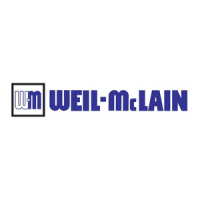



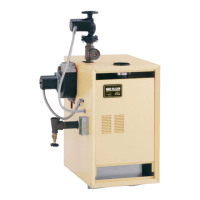
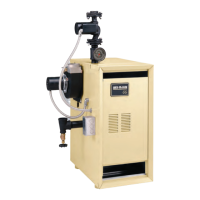

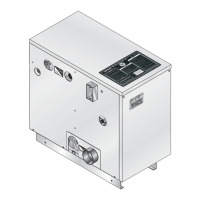
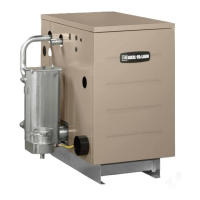


